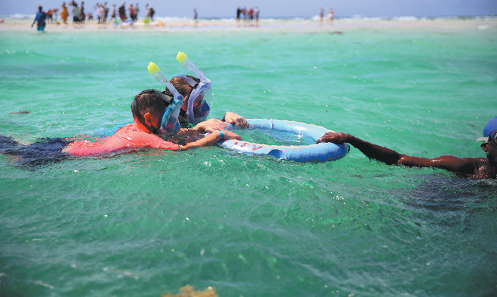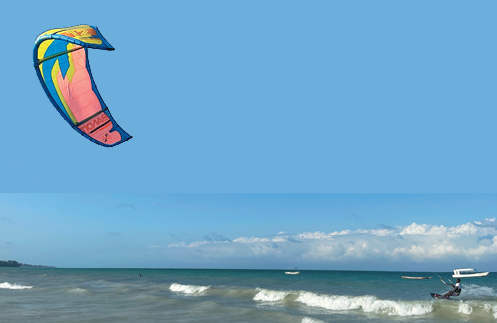Kenya's coastline offers water sports lovers a place to shine
Tourists find paradise perfect for fitness, fun, marine life and delicious bites

In addition to offering the best wildlife safari destinations, Kenya is known for its fantastic beaches along the east coast. Water sports activities such as kitesurfing, diving and game fishing have attracted tourists from around the world.
Facing the Indian Ocean, Kenya's eastern coastline stretches hundreds of kilometers and is dotted with towns that offer white sand beaches, clear crystal water, colorful coral reefs and a diverse culture. Among these, the more notable places include Lamu, an ancient town dating back centuries that features distinctive Arabic culture, Kenya's second-largest city of Mombasa, and the smaller but more serene towns of Diani, Watamu and Malindi.
Visitors can easily spend a relaxing long holiday in any of these destinations, whether submerging in warm tropical sunlight getting a tan, strolling with bare feet on the soft beaches enjoying beautiful sunsets or just enjoying the clear breeze lying in the shade of coconut trees, more restless tourists who opt for extreme activities have found their paradise too.
Maila Izi, a 22-year-old student at a music school in Hamburg, Germany, has always been a fan of water sports since she was a child. Over the past years, she has been to several countries, such as France and Spain, to learn new skills including wave surfing and windsurfing, but she thinks Diani offers the best water sports experiences.
"This is the first time I have visited but the sea is the most beautiful that I have ever seen," she said. "The sand beach is so wide, the water is so warm and I think it is the perfect place for kitesurfing. It's the most beautiful beach I have ever been on."
Having arrived in Diani with her parents for a May holiday, Izi decided to learn kitesurfing, a water activity that uses a kite and surfboard, which is a relatively new sport that has gained increasing popularity on Kenya's coast in recent years. She enrolled in a class that offered three hours of training, which included basic theory instruction and flying kites of different sizes, the largest measuring 10 square meters.
"I have always wanted to try kitesurfing," she said. "Since I am in the perfect place for the sport, why not try it here?"
Goodluck Shamala, the founder of Kenya Kitesurfing School, a training institute in Diani, said kitesurfing, which used to be considered an extreme sport, has in recent years become more popular among tourists with many coming from countries as far as Germany, France, the United Kingdom and the United States to experience it.
Kitesurfing began to develop in Kenya at the beginning of the century, and when the school was established in 2013, there were very few kitesurfing training schools in Diani, Shamala said. The number has increased to around 15 this year and more than 40 now exist in Kenya's coastal towns, he said, adding that he receives between 300 and 400 trainees every year.
"Back when I started the school, all the other kitesurfing training institutes were set up by foreigners, most of them from Europe and America," he said. "Nowadays more Kenyans are also practicing the sport, although they still account for only 10 percent of the total number."
According to Shamala's observation, over the past 10 years, kitesurfing has gained increasing popularity in Kenya, although there have been fluctuations, especially during the COVID-19 pandemic, when there was a big drop in the number of tourists. However, the market is picking up steadily again, he said.
Although an exciting sport, kitesurfing is not for everyone. Juma Nzaphila, a 30-year-old kitesurfing coach in Diani, said the sport requires good physical condition and strong swimming skills are a must.
"Not everybody can do this. If you're having a back problem or waist problem, then you cannot do it. We use the power from our back and waist when practicing kitesurfing," he said. "You must also be a good swimmer because you are doing the sport in water, so you have to know how to help yourself when you fall."
Challenging sport
Although it is a challenging sport, you don't need to have a strong body to master the skills to fly a giant kite while riding a board on the sea, according to Nzaphila.
"When we begin the kiting, everybody thinks it is about strength. They may think handling the kite uses just their muscles. It is a misconception," he said.
"For kitesurfing, we don't use strength. It's about technique, so it doesn't matter how strong you are. The technique is like yoga. You have to relax your mind and your body."
He said the most difficult part to learn in kitesurfing is kite control. In comparison, riding the board is much easier. "Once you feel the kite, it becomes much easier to do the water study," he said.
After obtaining some basic skills, the trainee has to keep practicing for perfection, Nzaphila said, adding that he practiced kitesurfing for four years before he became a coach.
Among the numerous beaches in Kenya, the ones in Diani are the best for kitesurfing, he said.
"Here there are fewer people and the beaches are not crowded, so there is a big space for learning," he said. "The wind is constant and but not very strong, and there are no rocks near the beaches."
However, accelerated global warming in recent years also has had an impact on the sport, said Nzaphila.
"Sometimes the weather can be unpredictable. During the peak season, there can be no wind sometimes," he said. "Cyclones from other places such as South Africa and Madagascar can also cause disruptions."
For Nzaphila, kitesurfing not only brings him employment but has also become a big part of his life.
"This is my life now because I like to exercise. I like to have good vibes and be social. So for me, it's like I'm getting everything," he said.
Despite the increasing popularity of the sport among tourists, kitesurfing is still growing compared with other popular water sports such as snorkeling, diving and game fishing, said Shamala, founder of Kenya Kitesurfing School.
In addition to the high demand for good physical condition, high expenses have been a major hurdle for sports lovers to kitesurf in African countries. A basic nine-hour training session costs at least $325, he said.
Also, many people in Kenya cannot swim, which also hinders the development of the sport in the country, he said.
The major equipment of kitesurfing, including the kite and board, cannot be locally produced, and nearly all of them in use in Kenya are imported from countries such as China. In addition, the kite can break easily, which adds to the costs, he said.
However, Shamala is optimistic that an increasing number of tourists will arrive in Diani in the coming years to experience this exciting sport, boosted by Kenya's visa-free policy and improved infrastructure in its coastal areas. Kenya has allowed visitors from all countries to enter without a visa since the beginning of the year.
Getting there
For the moment, most tourists from Mombasa, the second-largest city in Kenya, must take a ferry to cross a strait to arrive at Diani. Although the distance between the two places is just 40 kilometers, a car trip can take hours due to congestion during rush hours.
For tourists and business owners such as Shamala, the good news is a new road linking Mombasa and Diani bypassing the strait is almost completed and is expected to begin operations within the next two months, which will cut the trip to around half an hour.
In addition to kitesurfing, diving is also a popular activity along Kenya's coastal areas. The Kenyan Barrier Reef is one of the longest reefs in the world, extending 200 km from Malindi on the north to Shimoni on the south. This makes Kenya's eastern coast one of the world's greatest dive locations, comparable with the prestigious Great Barrier Reef in Australia and the Red Sea Reef in Egypt. Scuba diving and snorkeling in the various marine parks along Kenya's coast, which are abundant with rare marine life, offer unforgettable experiences for water-loving tourists from around the world.
Shee Lanjoro, owner of the diving center Yellow-fin Diani Beach Kenya, is a native of Diani. After teaching tourists diving for more than 10 years in Zanzibar, Tanzania, he returned to his hometown and opened a diving training center.
For Lanjoro, Diani offers an unparalleled diving experience, which even dwarfs the more famous Zanzibar islands just 200 km south of Diani.
"Zanzibar experiences over-tourism and people are not really keen on taking care of the reefs, in my opinion. And they fish with a lot of nets on the reefs," he said. "Here in Diani, after I came back and dived here, I see the reefs the same as I left them 12 years ago, with more sea turtles."
Due to fewer tourists and better environmental protection, Diani offers richer marine life than many other places, he said.
"If you go out, you will see sea turtles every day. They are not afraid of you so you can get close to them," Lanjoro said.
In addition to sea turtles, the waters near Diani are abundant in marine life, such as butterfly fish, parrot fish, lionfish and scorpion fish. If lucky, one can also see giants such as whale sharks and humpback whales, he said.
Although for most people diving is easier to learn than kitesurfing, one should also be free from certain illnesses before they try it, according to Lanjoro.
"Diving is risky. First, you need to do it with the right people. Second, you need to be water-friendly. Third, you are usually offered a medical questionnaire form," he said. "For example, you cannot dive when you have active asthma, obesity, high blood pressure, or if you've had a heart attack."
Besides Diani, many other coastal areas offer excellent water sports activities. In Mombasa, the blue waters are ideal for windsurfing, water skiing, snorkeling and diving. The Mombasa Marine National Park and Reserve is home to a rich variety of marine species, such as corals, turtles, crabs, starfish, stonefish, sea cucumbers and sea urchins. Watamu Marine National Park and Reserve, in the town of Watamu, which is most famous for green turtles, also offers a range of marine and tidal habitats. Visitors can enjoy the white sandy beaches and engage in various activities such as snorkeling, water skiing, windsurfing and glass-bottomed boat tours.
In addition to exciting water-sports activities, Kenya's eastern coast is also a paradise for seafood lovers. One of the unique seafood restaurants is Ali Barbour's Cave located in an underground cave in Diani. The restaurant is surrounded by lush jungles and diners must traverse a narrow and winding road to find it.
The most special part about the restaurant is that it is built inside a naturally formed cave said to be more than 180,000 years old. After entering a gate, visitors must follow the stairs to descend a few meters. The restaurant has no roof — the top of the cave is open. According to the staff, the restaurant only opens in the evening because the sun gets too hot during the daytime. The opening of the cave is also installed with retractable awnings in case of rain.
The restaurant's signature dishes include oysters, lobster, fish, prawns and octopus, as well as the seafood platter for two people to share, which is the most popular among tourists. Enjoying dinner in a cave under the stars is an unforgettable experience for tourists in Diani.



Today's Top News
- Xi hears report from Macao SAR chief executive
- Xi hears report from HKSAR chief executive
- UN envoy calls on Japan to retract Taiwan comments
- Innovation to give edge in frontier sectors
- Sanctions on Japan's former senior official announced
- Xi stresses importance of raising minors' moral standards





























